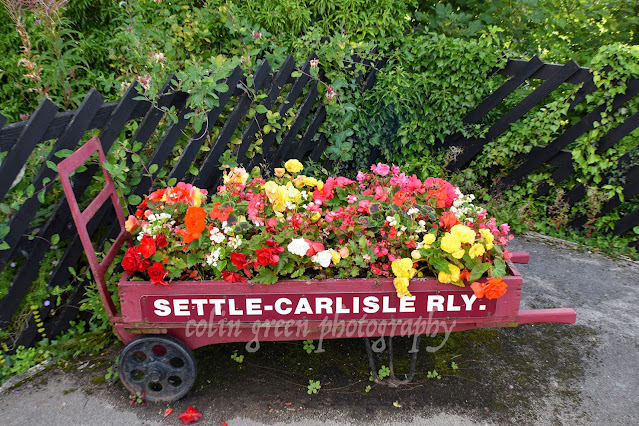While passing through the vibrant town of Hebden Bridge recently, my feet, familiar with its cobbled streets and independent spirit, instinctively led me towards the railway station. More than just a transport hub, Hebden Bridge Station stands as a proud testament to the region's rich industrial heritage, a living museum where the echoes of steam engines and bustling crowds still seem to linger. On this particular occasion, time was fleeting, allowing me only to capture the essence of the westbound platform – a snapshot that nevertheless speaks volumes about this remarkable place.
To declare Hebden Bridge Station the "best looking" in Calderdale is perhaps subjective, yet its undeniable charm lies in the remarkable preservation of its original character. Stepping onto the platform is akin to stepping back in time. The sturdy stone architecture, the intricate ironwork, and the thoughtful touches that whisper tales of a bygone era all contribute to an atmosphere rarely found in modern transport interchanges.
The station's story began in October 1840, a pivotal moment that initially marked the westernmost reach of the burgeoning railway line. Imagine the anticipation of that time, the sense of connection as Hebden Bridge became a crucial link in the unfolding railway network. Just a few short months later, on New Year's Eve of that same year, the line extended further, piercing through the formidable Summit Tunnel towards Walsden. This engineering marvel paved the way for through services from Leeds to the industrial heartlands of Manchester, commencing in March 1841, with Hebden Bridge playing a vital role as a key stop along this transformative route. The subsequent arrival of services to Halifax and Bradford in 1852 further cemented the station's importance in connecting the communities of the Calder Valley.
The current station buildings, completed in 1893, stand as enduring monuments to Victorian engineering and architectural style. One can almost picture the flurry of activity within their walls as passengers, goods, and news flowed through this vital artery. It's fascinating to consider that the very ground now occupied by the station car park once echoed with the sounds of a bustling goods yard, a hub of commerce until 1966. This transformation from industry to modern transport underscores the evolving role of the station within the community.
A thoughtful nod to the past arrived during the 1997 renovations with the installation of signage in the distinctive colours of the Lancashire and Yorkshire Railway. This subtle yet significant detail serves as a constant reminder of the station's historical roots, a visual thread connecting the present with its proud railway heritage.
Today, Hebden Bridge Station remains a vital and well-maintained gateway. Manned by helpful staff, it offers essential amenities such as toilets and ticket facilities. The presence of a small café provides a welcome space for commuters and visitors alike to grab a coffee and soak in the station's atmosphere. Its convenient location, with bus access immediately outside the main entrance, further enhances its role as a key transport link.
While progress has brought improvements, challenges remain. Currently, disabled access is available to the Leeds-bound platform, but reaching Platform 1, serving trains towards Lancashire and Manchester, still requires navigating steps. However, there is a promising glimmer of progress on the horizon with plans to reinstate the long-dormant lifts between the platforms, a much-needed improvement that will enhance accessibility for all. These lifts, sadly out of use since the 1980s, represent a tangible opportunity to fully modernize the station while respecting its historical fabric.
In terms of connectivity, Hebden Bridge Station offers a robust service. From Platform 1, three trains depart hourly towards Manchester, connecting the town to the wider northwest region, alongside an additional hourly service to Preston. Platform 2 buzzes with even greater frequency, offering four Leeds-bound services each hour, providing connections to the vibrant city and beyond. Notably, these services offer different routes, with three traversing the bustling interchange of Bradford and another heading through the historic town of Dewsbury, offering a variety of travel options for passengers.
Captured on a sunny August afternoon in 2017 with my trusty Nikon D3300, the photograph I took offers a small window into the enduring appeal of Hebden Bridge Station. It's more than just bricks and mortar; it's a living link to the past, a vital artery for the present, and a place brimming with the quiet dignity of a station that has faithfully served its community for nearly two centuries. As I moved on, the image of the westbound platform remained with me, a reminder of the beauty and history that can be found in the most unexpected of places, waiting to be appreciated by those who take a moment to look closer.
Clicking any image should open a link in another window to my Colin Green photography store on Zazzle.











































%20Church,%20Todmorden%20a%2012%20x%208.jpg)
%20Church,%20Todmorden%20b%2012%20x%208.jpg)
%20Church,%20Todmorden%20c%2012%20x%208.jpg)
%20Church,%20Todmorden%20d%2012%20x%208%20copy.jpg)
%20Church,%20Todmorden%20e%2012%20x%208.jpg)
%20Church,%20Todmorden%20f%2012%20x%208.jpg)
%20Church,%20Todmorden%20f%2012%20x%208.jpg)
















